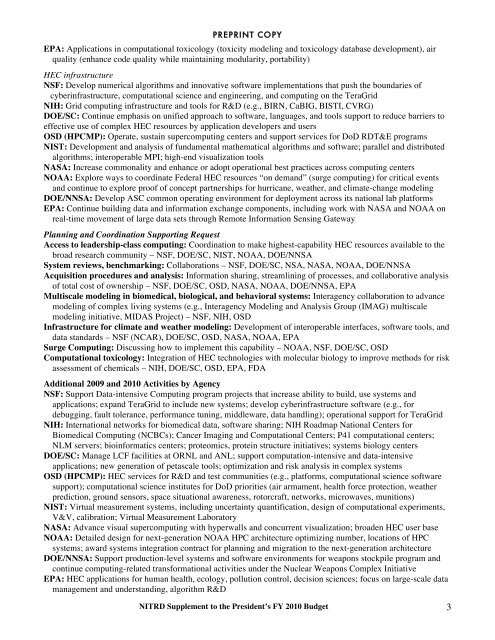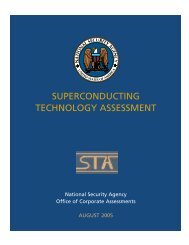Untitled - nitrd
Untitled - nitrd
Untitled - nitrd
- No tags were found...
Create successful ePaper yourself
Turn your PDF publications into a flip-book with our unique Google optimized e-Paper software.
PREPRINT COPYEPA: Applications in computational toxicology (toxicity modeling and toxicology database development), airquality (enhance code quality while maintaining modularity, portability)HEC infrastructureNSF: Develop numerical algorithms and innovative software implementations that push the boundaries ofcyberinfrastructure, computational science and engineering, and computing on the TeraGridNIH: Grid computing infrastructure and tools for R&D (e.g., BIRN, CaBIG, BISTI, CVRG)DOE/SC: Continue emphasis on unified approach to software, languages, and tools support to reduce barriers toeffective use of complex HEC resources by application developers and usersOSD (HPCMP): Operate, sustain supercomputing centers and support services for DoD RDT&E programsNIST: Development and analysis of fundamental mathematical algorithms and software; parallel and distributedalgorithms; interoperable MPI; high-end visualization toolsNASA: Increase commonality and enhance or adopt operational best practices across computing centersNOAA: Explore ways to coordinate Federal HEC resources “on demand” (surge computing) for critical eventsand continue to explore proof of concept partnerships for hurricane, weather, and climate-change modelingDOE/NNSA: Develop ASC common operating environment for deployment across its national lab platformsEPA: Continue building data and information exchange components, including work with NASA and NOAA onreal-time movement of large data sets through Remote Information Sensing GatewayPlanning and Coordination Supporting RequestAccess to leadership-class computing: Coordination to make highest-capability HEC resources available to thebroad research community – NSF, DOE/SC, NIST, NOAA, DOE/NNSASystem reviews, benchmarking: Collaborations – NSF, DOE/SC, NSA, NASA, NOAA, DOE/NNSAAcquisition procedures and analysis: Information sharing, streamlining of processes, and collaborative analysisof total cost of ownership – NSF, DOE/SC, OSD, NASA, NOAA, DOE/NNSA, EPAMultiscale modeling in biomedical, biological, and behavioral systems: Interagency collaboration to advancemodeling of complex living systems (e.g., Interagency Modeling and Analysis Group (IMAG) multiscalemodeling initiative, MIDAS Project) – NSF, NIH, OSDInfrastructure for climate and weather modeling: Development of interoperable interfaces, software tools, anddata standards – NSF (NCAR), DOE/SC, OSD, NASA, NOAA, EPASurge Computing: Discussing how to implement this capability – NOAA, NSF, DOE/SC, OSDComputational toxicology: Integration of HEC technologies with molecular biology to improve methods for riskassessment of chemicals – NIH, DOE/SC, OSD, EPA, FDAAdditional 2009 and 2010 Activities by AgencyNSF: Support Data-intensive Computing program projects that increase ability to build, use systems andapplications; expand TeraGrid to include new systems; develop cyberinfrastructure software (e.g., fordebugging, fault tolerance, performance tuning, middleware, data handling); operational support for TeraGridNIH: International networks for biomedical data, software sharing; NIH Roadmap National Centers forBiomedical Computing (NCBCs); Cancer Imaging and Computational Centers; P41 computational centers;NLM servers; bioinformatics centers; proteomics, protein structure initiatives; systems biology centersDOE/SC: Manage LCF facilities at ORNL and ANL; support computation-intensive and data-intensiveapplications; new generation of petascale tools; optimization and risk analysis in complex systemsOSD (HPCMP): HEC services for R&D and test communities (e.g., platforms, computational science softwaresupport); computational science institutes for DoD priorities (air armament, health force protection, weatherprediction, ground sensors, space situational awareness, rotorcraft, networks, microwaves, munitions)NIST: Virtual measurement systems, including uncertainty quantification, design of computational experiments,V&V, calibration; Virtual Measurement LaboratoryNASA: Advance visual supercomputing with hyperwalls and concurrent visualization; broaden HEC user baseNOAA: Detailed design for next-generation NOAA HPC architecture optimizing number, locations of HPCsystems; award systems integration contract for planning and migration to the next-generation architectureDOE/NNSA: Support production-level systems and software environments for weapons stockpile program andcontinue computing-related transformational activities under the Nuclear Weapons Complex InitiativeEPA: HEC applications for human health, ecology, pollution control, decision sciences; focus on large-scale datamanagement and understanding, algorithm R&DNITRD Supplement to the President’s FY 2010 Budget 3










